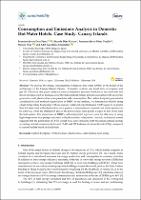Por favor, use este identificador para citar o enlazar este ítem:
https://repositorio.usj.es/handle/123456789/306
Registro completo de metadatos
| Campo DC | Valor | Lengua/Idioma |
|---|---|---|
| dc.contributor.author | Díaz Pérez, F. J. | - |
| dc.contributor.author | Pino Otín, Rosa | - |
| dc.contributor.author | Guardiola Mouhaffel, Ali Adib | - |
| dc.contributor.author | Díaz Martín, Ricardo | - |
| dc.contributor.author | Chinarro Vadillo, David | - |
| dc.date.accessioned | 2020-01-20T13:43:24Z | - |
| dc.date.available | 2020-01-20T13:43:24Z | - |
| dc.date.issued | 2018-03-16 | - |
| dc.identifier.citation | F. J. Díaz Pérez, M. R. Pino Otín, A. G. Mouhaffel, R. D. Martín and D. Chinarro, "Energy and Water Consumption and Carbon Footprint in Tourist Pools Supplied by Desalination Plants: Case Study, the Canary Islands," in IEEE Access, vol. 6, pp. 11727-11737, 2018. | es_ES |
| dc.identifier.issn | 21693536 | es_ES |
| dc.identifier.uri | https://repositorio.usj.es/handle/123456789/306 | - |
| dc.description | We analyze the consumption of water and energy produced by tourist swimming pools andhow it affects the water needs of the destinations, as well as the carbon footprint generated by the productionof this water by industrial methods. By means of the data of water consumption from 42 tourist swimmingpools on the Canary Islands (Spain), we investigate the expenses associated with them by means of simpleand multivariate linear regression methods, obtaining the characteristic function that defines the water andenergy consumption. With the algorithm obtained and the data of all the tourist swimming pools in theregion, the water needs for the collective whole of these facilities were calculated. Considering that morethan 90% of the drinking water supplied in the islands comes from desalination plants using seawater reverseosmosis (SWRO), it is hypothesised that all supplies will be satisfied through these types of installation,calculating the energy requirements and the Scope 2 carbon footprint of generating the water needed tomeet the requirements of all swimming pools. It can be observed that the carbon footprint is 28.16% higherthrough centralized production, compared with local production, due to large losses in the supply networks.The generation of the water necessary for tourist swimming pools through SWRO would represent between0.089% and 0.114% of all emissions in the region, according to the type of supply, local or centralized,respectively—extremely significant values and equivalent to the biological treatment of all solid waste fromthe islands. | es_ES |
| dc.format.mimetype | application/pdf | es_ES |
| dc.language.iso | eng | es_ES |
| dc.publisher | Institute of Electrical and Electronics Engineers Inc | es_ES |
| dc.rights | Attribution-NonCommercial-NoDerivatives 4.0 Internacional | * |
| dc.rights.uri | http://creativecommons.org/licenses/by-nc-nd/4.0/ | * |
| dc.subject | Turismo canario | es_ES |
| dc.subject | Huella de carbono | es_ES |
| dc.subject | Emisiones | es_ES |
| dc.subject | Energía | es_ES |
| dc.subject | GHG | es_ES |
| dc.subject | Piscinas públicas | es_ES |
| dc.subject | SWRO | es_ES |
| dc.title | Energy and Water Consumption and Carbon Footprint in Tourist Pools Supplied by Desalination Plants: Case Study, the Canary Islands | es_ES |
| dc.type | journal article | es_ES |
| dc.subject.unesco | Energía eléctrica | es_ES |
| dc.identifier.publicationfirstpage | 11727 | es_ES |
| dc.identifier.publicationlastpage | 11737 | es_ES |
| dc.identifier.doi | 10.1109/ACCESS.2018.2808923 | es_ES |
| dc.rights.accessRights | open access | es_ES |
| Aparece en las colecciones: | Artículos de revistas | |
Ficheros en este ítem:
| Fichero | Descripción | Tamaño | Formato | |
|---|---|---|---|---|
| Consumption and emissions analysis in domestic hot water hotels. Case study Canary Islands.pdf | 2,11 MB | Adobe PDF |  Visualizar/Abrir |
Este ítem está sujeto a una licencia Creative Commons Licencia Creative Commons

